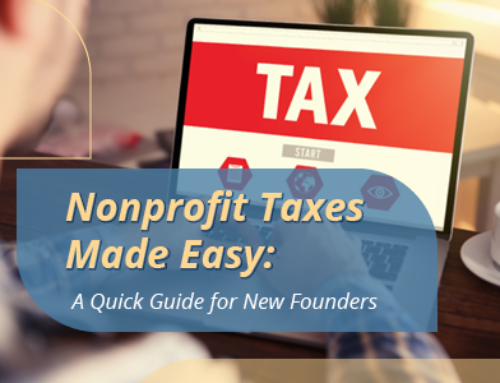
Your nonprofit is growing, reaching more people and changing more lives, and it’s time to think about hiring staff for your nonprofit.
It can be a paralyzing thought, taking on the responsibility of paid employees.
Initially, there is the stress of expanding your budget to pay them.
But then there’s more. You have to:
- Find people with the right skills and a commitment to your organization’s mission.
- Create policies and procedures, so everyone is treated fairly.
- Create a work environment where everyone can thrive.
It’s a lot to take on! But, consider the alternative: continuing to do everything yourself, with sporadic support from Board members and volunteers.
Look, even when you have a wonderful team of volunteers, it is hard to grow your organization and realize its full potential without paid staff.
So where do you start? At the beginning! Let’s define what you need.
What People Does Your Organization Need?
First things first, are YOU getting paid?
If you’re not, you need to be your first hire!
Check out our guide on When and How to Pay Yourself a Nonprofit Salary to get yourself on a path to getting paid.
If you forgo your own salary in favor of hiring staff first, you may never get paid. And that’s not sustainable.
Plus, it can make you resentful and that won’t help anything.
So make sure YOU get paid first, then start thinking about who you need to hire next.
 The first step in hiring staff for your nonprofit is determining what your organization needs. It’s easy to throw your hands up and say EVERYTHING, but that’s not helpful.
The first step in hiring staff for your nonprofit is determining what your organization needs. It’s easy to throw your hands up and say EVERYTHING, but that’s not helpful.
In short, be specific.
Think about your goals and what position you could add that would move you forward quickly toward reaching your goals.
Think about your personal daily work routine and all the tasks and goals that fall by the wayside because one person can only do so much.
Write it all down so you can see it in black and white. What stands out as the most important tasks?
Now, hiring someone doesn’t mean you need to hire a full-time person right off the bat.
What would you be able to do with a part-time employee? What would that employee’s day look like? Would just a few hours a week take enough off your plate so you can breathe and focus on other things?
Founders of nonprofits often want their first hire to be a fundraiser. That way, the founder can focus on programs. That might be the right move. But consider how passionate you are about the organization you founded and how important that passion is in fundraising.
More likely, your organization would benefit from an employee providing administrative support across fundraising and programs, with you setting strategy and remaining the face of the organization.
Think about your strengths and weaknesses and how you could craft a position for a first hire that could complement you. Together, as a team, you want to be greater than the sum of your parts.
I have seen founders have success hiring a first employee to take over social media, email marketing, gift entry and acknowledgments, and event planning. The founder drives the vision, the brand, and the messaging. The employee makes sure all the tasks get done.
I’ve also seen a bookkeeper or office manager as a first hire, especially when the founder isn’t great with numbers. Solid books and numbers make everything easier, especially when you’re ready to go after grants.
A full-time employee in a supporting role might also handle some aspects of program work, such as recruiting and training volunteers, planning volunteer events, and working on the logistical details of program management.
There are many other ways to structure the responsibilities of your first hire. The key is to make sure your new hire meets your organization’s needs and moves your organization forward.
Once you have thought through your first hire, fast forward to your second hire. What do you envision your second hire doing to move your organization forward?
Keep thinking through each future hire until you reach a place where it feels like your organization would have the people in place to fulfill your mission. Think three to five years into the future. Draw it out into an organizational chart so you can see who will report to who.
Now that you have a plan for the employees you need to hire, it’s time to figure out how you are going to cover payroll.
Raising the money you need to build a team
Let’s say your plan for hiring staff for your nonprofit includes four full-time employees, in addition to yourself as the Executive Director:
- a Program Coordinator
- two counselors to meet the needs of participants in your program
- a Director of Development to build up a fundraising program that keeps the money coming in
That’s a hefty payroll, in the neighborhood of $250,000 – $300,000 depending on where you are located, how tight the labor market is, and the depth of experience each position requires. (This ballpark estimate takes into account a healthcare benefit.)
If your stomach just started to hurt, take a breath. It’s all ok. You might need to ease into this instead of hiring everyone at once.
When you’re ready, look at how much money you currently raise and think about what you need to do to increase your budget and hire the staff you need. How many years will it take you to get there if you increase your budget by 10% a year? 20% a year?
It might be hard to look at these figures and to wrap your brain around how much money you need to raise to employ the staff you need. But you can’t get where you need to go if you don’t look at the numbers.
In nonprofit-speak, you are probably looking at a capacity-building campaign- a big push in fundraising to increase your organization’s capacity, fulfill your mission, and change more lives.
Some organizations launch an official Capacity-Building Campaign. Others develop an internal plan to grow all the pieces of their fundraising pie, including grants, individual donors, major donors, monthly donors, corporate partners, and a signature event.
Build out a timeline for gradually adding staff that aligns with your fundraising goals. It may make sense for roles to start part-time, with a plan to go full-time down the line. And you may have to extend your timeline while you build support from funders.
The important thing is that you map out a plan and get Board buy-in. Otherwise you will remain on the treadmill of doing almost everything yourself with support from volunteers, while wishing for a team of paid employees.
A plan is how you make your wish a reality.
The Job Description for Your First Hire
 When hiring staff for your nonprofit, the first hire can be the most intimidating.
When hiring staff for your nonprofit, the first hire can be the most intimidating.
You’ve probably got a learning curve ahead of you.
Start with a job description. You have probably been fleshing one out in your head while thinking through the process of building a team, even if you didn’t realize that’s what you were doing.
Now it’s time to write a job description for real, one that you can use to make your first hire.
Study job descriptions on job sites such as Idealist and LinkedIn. Focus on the job descriptions for organizations you admire.
Craft a job description that lets prospective candidates know what they will be expected to do and what skills are required, but don’t overwhelm them with unrealistic expectations. Put yourself in their shoes – could you do this job? Would you do this job?
There is an expression in the nonprofit sector about looking for a unicorn. A unicorn is an employee so perfect, wonderful, multi-gifted, and magical that you have to wonder if such an employee even exists.
Take it from me, unicorns don’t exist.
Craft a job description that is realistic for a mortal.
Don’t expect someone who has a social worker background and program experience to also know how to design graphics for social media and be amazing on video. Don’t expect someone to be a whiz at photography, video editing, design software, analytics, email marketing, and event planning all at the same time.
Write a job description that will attract candidates with a range of skills that your organization needs and the willingness to develop any associated skills they might be lacking.
Include the salary range in the job description. Do not say “salary commensurate with experience.” If you don’t post a salary range, you will miss out on résumés from applicants who don’t want to waste their time applying for a role that might not offer the salary they need.
Set a closing date for résumés. Leave the window open for three to four weeks, and be prepared to extend the listing if you do not get the candidates you want.
Speaking of listings, post your job description in several places, including Idealist, Indeed, and LinkedIn. Then circulate it among your contacts. Ask Board members to share the job description with their contacts. Heck, even mention it on your social media and in your nonprofit’s newsletter!
Then, see who wants to come work for your organization!
Prepare To Welcome a New Hire
While you are receiving résumés, get your organization ready to make a hire.
That’s a lot to do and that’s why we recommend getting your nonprofit ready while you’re collecting resumes. Once you have some good candidates, it’s time for the next step, which is interviewing.
The Interview Process
Now that resumes have come in, it’s time to narrow down your candidates to those with the right qualifications.
Get ready, you are about to welcome your first hire!
Create a Comfortable, Inspiring Work Environment
 Think about the jobs you had in the past. How did you feel those first few weeks on the job?
Think about the jobs you had in the past. How did you feel those first few weeks on the job?
You probably felt awkward and insecure. It is hard not to feel stupid when you have to ask a lot of questions.
Minimize that for your new hire by creating the work environment you needed when you were new!
Working at a small nonprofit can be hard work.
Most people who work in nonprofits could be making more money elsewhere.
But you know what? People work in nonprofits because they want to be part of something important. Go out of your way to make sure your new hire feels like they are part of the great work your organization is doing.
The Bottom Line
 Hiring your first paid employee is a big step. Heck, making a plan to hire staff is a big step. It’s an acknowledgment that you can’t walk this road alone forever. It’s a challenge to yourself to increase your fundraising so you can take your organization to the next level.
Hiring your first paid employee is a big step. Heck, making a plan to hire staff is a big step. It’s an acknowledgment that you can’t walk this road alone forever. It’s a challenge to yourself to increase your fundraising so you can take your organization to the next level.
By mapping out the employees you need for your organization to grow and thrive, you can calculate how much money you need to raise. And, wow, that can be a scary number! But with planning and the right strategies, you can get there.
And when you start hiring staff for your nonprofit, you can create the workplace you want to work for, one that values everyone on the team. And that’s when your organization can really take off.
As you build your team, you will be able to expand programs and change more lives. And that’s what it’s all about!

 Onboarding. Think about how you’ll orient your new person. You should provide a thorough introduction to the organization and its values, mission, vision, Board, current programs, strategic plan, fundraising plan, and brand.
Onboarding. Think about how you’ll orient your new person. You should provide a thorough introduction to the organization and its values, mission, vision, Board, current programs, strategic plan, fundraising plan, and brand.




Leave A Comment